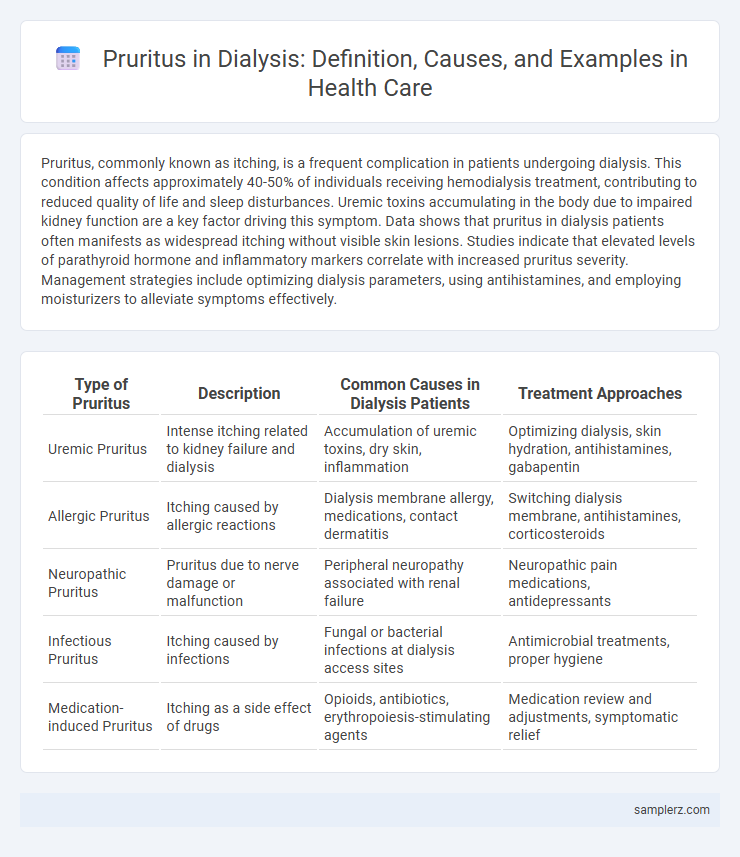Pruritus, commonly known as itching, is a frequent complication in patients undergoing dialysis. This condition affects approximately 40-50% of individuals receiving hemodialysis treatment, contributing to reduced quality of life and sleep disturbances. Uremic toxins accumulating in the body due to impaired kidney function are a key factor driving this symptom. Data shows that pruritus in dialysis patients often manifests as widespread itching without visible skin lesions. Studies indicate that elevated levels of parathyroid hormone and inflammatory markers correlate with increased pruritus severity. Management strategies include optimizing dialysis parameters, using antihistamines, and employing moisturizers to alleviate symptoms effectively.
Table of Comparison
| Type of Pruritus | Description | Common Causes in Dialysis Patients | Treatment Approaches |
|---|---|---|---|
| Uremic Pruritus | Intense itching related to kidney failure and dialysis | Accumulation of uremic toxins, dry skin, inflammation | Optimizing dialysis, skin hydration, antihistamines, gabapentin |
| Allergic Pruritus | Itching caused by allergic reactions | Dialysis membrane allergy, medications, contact dermatitis | Switching dialysis membrane, antihistamines, corticosteroids |
| Neuropathic Pruritus | Pruritus due to nerve damage or malfunction | Peripheral neuropathy associated with renal failure | Neuropathic pain medications, antidepressants |
| Infectious Pruritus | Itching caused by infections | Fungal or bacterial infections at dialysis access sites | Antimicrobial treatments, proper hygiene |
| Medication-induced Pruritus | Itching as a side effect of drugs | Opioids, antibiotics, erythropoiesis-stimulating agents | Medication review and adjustments, symptomatic relief |
Understanding Pruritus in Dialysis Patients
Pruritus in dialysis patients, also known as uremic pruritus, affects approximately 40-50% of individuals undergoing hemodialysis, significantly impairing quality of life. This condition results from the accumulation of toxins such as parathyroid hormone and histamine due to impaired renal clearance, triggering chronic itch sensations. Effective management includes optimizing dialysis adequacy, controlling electrolyte imbalances, and using pharmacological treatments like gabapentin or topical emollients to alleviate symptoms.
Common Causes of Pruritus During Dialysis
Pruritus during dialysis, often referred to as uremic pruritus, commonly arises due to the accumulation of metabolic waste products such as urea and phosphate in patients with end-stage renal disease. Secondary factors include dry skin (xerosis), hyperparathyroidism leading to elevated calcium-phosphate product, and chronic inflammation marked by elevated cytokines like interleukin-6. Dialysis-related causes also encompass inadequate dialysis clearance and the use of certain dialysate components, which can exacerbate itching sensations in these patients.
Uremic Pruritus: A Frequent Dialysis Complication
Uremic pruritus affects up to 50% of dialysis patients, manifesting as persistent, intense itching primarily due to the accumulation of uremic toxins in the skin. This condition significantly reduces quality of life and is linked to systemic inflammation and mineral metabolism disorders commonly observed in end-stage renal disease. Treatment strategies include optimizing dialysis adequacy, using gabapentin or pregabalin, and controlling serum phosphate levels to alleviate symptoms.
Clinical Manifestations of Dialysis-Related Itch
Pruritus in dialysis patients often presents as generalized or localized itching, predominantly affecting the back, arms, and face, which can worsen at night. Clinical manifestations include xerosis, excoriations, and secondary skin infections due to persistent scratching. Elevated serum levels of parathyroid hormone, calcium, and phosphate are frequently associated with the severity of dialysis-related itch.
Impact of Pruritus on Quality of Life for Dialysis Patients
Pruritus affects up to 50% of dialysis patients, causing intense itching that severely disrupts sleep, leading to chronic fatigue and impaired cognitive function. This persistent discomfort contributes to heightened stress, anxiety, and depression, significantly diminishing overall health-related quality of life. Effective management of pruritus is critical to improve patient well-being and adherence to dialysis treatment protocols.
Identifying Risk Factors for Pruritus in Dialysis
Pruritus in dialysis patients is commonly linked to risk factors such as elevated serum calcium and phosphate levels, inadequate dialysis clearance, and secondary hyperparathyroidism. Chronic inflammation and xerosis also play significant roles in exacerbating uremic pruritus among individuals undergoing hemodialysis or peritoneal dialysis. Understanding these factors is essential for targeted interventions to improve patient quality of life and reduce pruritus severity.
Diagnostic Approach to Dialysis-Associated Pruritus
Dialysis-associated pruritus (DAP), experienced by 40-50% of hemodialysis patients, requires a comprehensive diagnostic approach including detailed patient history, physical examination for skin conditions, and laboratory investigations such as serum calcium, phosphate, parathyroid hormone levels, and markers of inflammation like C-reactive protein. Assessing dialysis adequacy through metrics such as Kt/V and evaluating for potential xerosis or secondary infections helps differentiate DAP from other causes of pruritus. Skin biopsy is rarely needed but may be considered if diagnostic uncertainty persists after initial evaluations.
Management Strategies for Pruritus in Dialysis Care
Management strategies for pruritus in dialysis care include the use of topical emollients to maintain skin hydration and reduce dryness-induced itching. Antihistamines and gabapentin have demonstrated efficacy in alleviating neuropathic pruritus associated with dialysis. Optimizing dialysis adequacy and correcting mineral imbalances such as hyperphosphatemia further contribute to pruritus relief in end-stage renal disease patients.
Case Studies: Real-Life Examples of Pruritus in Dialysis
Case studies reveal that pruritus affects up to 50% of dialysis patients, significantly impairing their quality of life. One documented case involved a 65-year-old male undergoing hemodialysis who experienced severe generalized itching unrelieved by antihistamines, later managed effectively with gabapentin. Another example highlighted a 48-year-old female on peritoneal dialysis presenting with nocturnal pruritus, which improved after optimizing calcium-phosphate metabolism and topical emollients.
Preventive Measures for Pruritus in Dialysis Patients
Preventive measures for pruritus in dialysis patients include maintaining optimal dialysis adequacy to reduce toxin accumulation, managing serum phosphate and calcium levels through dietary restrictions and phosphate binders, and ensuring skin hydration with regular use of emollients. Controlling systemic inflammation with medications such as antihistamines or gabapentin can also help minimize itching severity. Regular monitoring of parathyroid hormone levels and adjusting treatment protocols accordingly reduces the risk of uremic pruritus.

example of pruritus in dialysis Infographic
 samplerz.com
samplerz.com